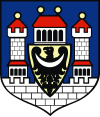Krosno Odrzańskie
| Krosno Odrzańskie | ||
|---|---|---|

Parish Church (Fara)
|
||
|
||
| Coordinates: 52°2′N 15°6′E / 52.033°N 15.100°E | ||
| Country |
|
|
| Voivodeship | Lubusz | |
| County | Krosno Odrzańskie County | |
| Gmina | Gmina Krosno Odrzańskie | |
| Town rights | before 1238 | |
| Government | ||
| • Mayor | Marek Cebula | |
| Area | ||
| • Total | 8.11 km2 (3.13 sq mi) | |
| Highest elevation | 85 m (279 ft) | |
| Lowest elevation | 38 m (125 ft) | |
| Population (2006) | ||
| • Total | 12,100 | |
| • Density | 1,500/km2 (3,900/sq mi) | |
| Time zone | CET (UTC+1) | |
| • Summer (DST) | CEST (UTC+2) | |
| Postal code | 66-600 to 66-603 | |
| Area code(s) | +48 68 | |
| Car plates | FKR | |
| Website | http://www.krosnoodrzanskie.pl | |
Krosno Odrzańskie [ˈkrɔsnɔ ɔˈdʐaɲskʲɛ] (German: Crossen an der Oder) is a city on the east bank of Oder River, at the confluence with the Bóbr. The town in Western Poland with 12,500 inhabitants (2002) is the capital of Krosno County. It is assigned to the Lubusz Voivodeship (since 1999), previously part of Zielona Góra Voivodeship (1975–1998).
The town was first mentioned as Crosno in 1005, when Duke Bolesław I Chrobry of Poland had a fortress built here in the course of his armed conflict with Emperor Henry II and the West Slavic Veleti confederation. Due to its strategic location, it played an important role at the western border of the Polish kingdom with the Holy Roman Empire during the 11th to 13th centuries. In 1163 Krosno was part of the Duchy of Silesia ruled by Bolesław I the Tall of the Silesian Piasts at Wrocław. In 1201 it received its town charter by Bolesław's son Duke Henry I the Bearded. Henry erected a stone castle at Krosno, where he died in 1238 and where his widow, Hedwig of Andechs, took refuge during the 1241 Mongol invasion of Europe. When the Duchy of Wrocław was finally divided in 1251, the town became part of the newly created Duchy of Głogów under Konrad I.
...
Wikipedia


